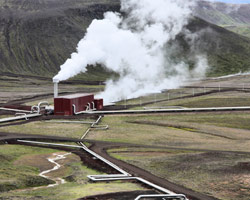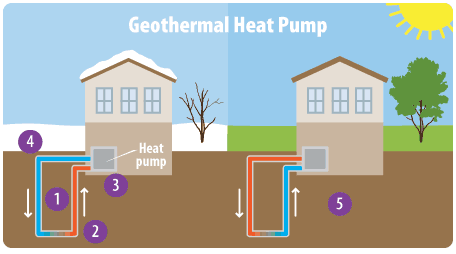Geothermal Energy

If you were to dig a big hole straight down into the Earth, you would notice the temperature getting warmer the deeper you go. That's because the inside of the Earth is full of heat. This heat is called geothermal energy.
People can capture geothermal energy through:
- Geothermal power plants, which use heat from deep inside the Earth to generate steam to make electricity.
- Geothermal heat pumps, which tap into heat close to the Earth's surface to heat water or provide heat for buildings.
Geothermal Power Plants
At a geothermal power plant, wells are drilled 1 or 2 miles deep into the Earth to pump steam or hot water to the surface. You're most likely to find one of these power plants in an area that has a lot of hot springs, geysers, or volcanic activity, because these are places where the Earth is particularly hot just below the surface.
How It Works

- Hot water is pumped from deep underground through a well under high pressure.
- When the water reaches the surface, the pressure is dropped, which causes the water to turn into steam.
- The steam spins a turbine, which is connected to a generator that produces electricity.
- The steam cools off in a cooling tower and condenses back to water.
- The cooled water is pumped back into the Earth to begin the process again.
Geothermal Heat Pumps
Not all geothermal energy comes from power plants. Geothermal heat pumps can do all sorts of things—from heating and cooling homes to warming swimming pools. These systems transfer heat by pumping water or a refrigerant (a special type of fluid) through pipes just below the Earth's surface, where the temperature is a constant 50 to 60°F.
During the winter, the water or refrigerant absorbs warmth from the Earth, and the pump brings this heat to the building above. In the summer, some heat pumps can run in reverse and help cool buildings.
How It Works

- Water or a refrigerant moves through a loop of pipes.
- When the weather is cold, the water or refrigerant heats up as it travels through the part of the loop that's buried underground.
- Once it gets back above ground, the warmed water or refrigerant transfers heat into the building.
- The water or refrigerant cools down after its heat is transferred. It is pumped back underground where it heats up once more, starting the process again.
- On a hot day, the system can run in reverse. The water or refrigerant cools the building and then is pumped underground where extra heat is transferred to the ground around the pipes.
Watch a video to learn more about how geothermal heat pumps can heat and cool your home.![]()
Cool Facts
- Looking to the past. People have used geothermal energy for thousands of years. Ancient Romans, Chinese, and Native American cultures used hot mineral springs for bathing, cooking, and eating.
- Hot stuff! Most people in Iceland use geothermal energy to heat water and buildings.
- Ring of Fire. Many of the best locations for geothermal energy are found in the “Ring of Fire,” a horseshoe–shaped area around the Pacific Ocean that experiences a lot of earthquakes and volcanic eruptions. That's because hot magma is very close to the Earth's surface there.